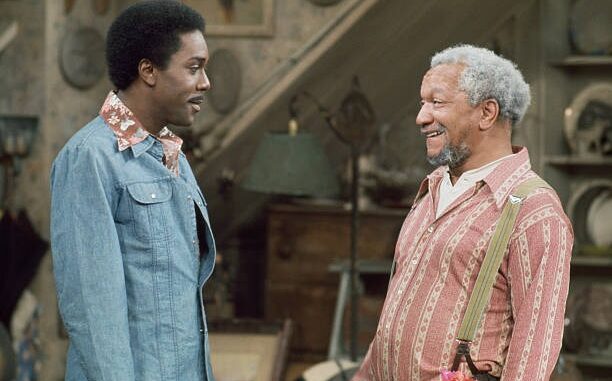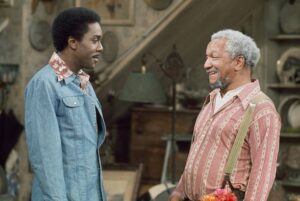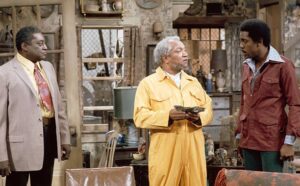
As the ’70s sitcom marks its fiftieth anniversary, it’s worth recalling how this funny series broke serious ground.
He was a white guy writing scripts for one of the most venerated Black sitcom stars in tv history. So, during his time on the NBC hit Sanford and Son, Ted Bergman was occasionally corrected by star Redd Foxx and the mostly Black cast for asking them to do or say something that Black people probably wouldn’t say or do.
Once, Bergman wrote a scene in which Foxx’s character, Fred G. Sanford, was playing Monopoly with his longtime friend Grady Wilson (Whitman Mayo). Fred’s son Lamont (Demond Wilson) walks by and asks why they’re playing a kid’s game. Fred replies, essentially, that it’s the only game in which a Black man can own railroads, power companies and utilities.

But Foxx nixed the exchange, Bergman says, and they eventually created an entirely new scene for the episode. Why?
“Redd said, ‘Black people don’t play Monopoly,'” Bergman recalls, laughing.
Reality wasn’t often a stumbling block for Sanford and Son. It took a relatively simple setup — a widowed junk dealer and his son share a home and business on South Central Avenue in the L.A. neighborhood of Watts — and blew it up into storylines that had Fred sneaking into the dressing room of star Lena Horne and Lamont running for public office.
But it was a groundbreaking series. Before Good Times and The Jeffersons would make TV history with powerful stories focused on Black families, Sanford and Son would explore the prickly relationship between a middle-aged Black man and his son amid the absence of Fred’s beloved, late wife Elizabeth.
Before stand-up comics would regularly land their own sitcoms, Sanford and Son would turn Foxx — a streetwise comic who came up through Black-oriented nightclubs known as the “chitlin’ circuit” — into a worldwide star.
And before networks would feature a spate of comedies centered on Black families in poor neighborhoods — shows like Good Times and What’s Happening!!, sometimes called “ghetto-coms” — Sanford and Son would mine laughs in a setting that in real life had been torn apart over police abuse issues not long before, during the Watts Riots of August 1965.
In part, because there were so few Black writers established in Hollywood, sitcoms like Sanford and Son were created by white producers and staffed mostly by white writers producing lines for predominantly Black casts (though comedy legends Richard Pryor and Paul Mooney were among the Black writers who contributed scripts).
Bergman, who wrote about his experiences on Sanford and Son in his book Confessions of a Rogue TV Comedy Writer, says navigating racial issues on the show wasn’t much of a problem for him.
“Redd Foxx was interested in getting laughs,” says the writer, who joined the show just after Foxx ended an infamous walkout over a pay dispute, solidifying his control over the series. “He wasn’t really interested in social injustices, other than he was a Black man in 1975, ten years removed from the [civil rights] march in Selma [Alabama] and water cannons and attack dogs. I just wrote what I thought was funny and let the cast handle the rest.”

Still, as Sanford and Son approaches the fiftieth anniversary of its January 1972 debut — there is a sense that the show remains unappreciated as an innovative and trend-setting comedy. The story of how it became a massive hit would affect the course of television for years to come.
Many fans may know that All in the Family was based on the British sitcom ‘Til Death Us Do Part. But Sanford and Son was also based on a British TV comedy, Steptoe and Son, which ran from 1962 to ’65, then ’70 to ’74, and centered on a father-and-son junkyard business in London.
Legendary producer Norman Lear, who created All in the Family, developed Sanford and Son with his producing partner Bud Yorkin, who would take over as showrunner. In his memoir, Even This I Get to Experience, Lear recounts that he and Yorkin had seen Foxx perform in Las Vegas and loved his originality and comic voice.
As Lear tells it, the show was actually bought by one network under the roof of another. Because All in the Family was a CBS show, Lear was renting a small studio at CBS to rehearse Foxx and Wilson for the Sanford and Son pilot.
Though he asked CBS executives to stop by, Lear says no one there found the time. So he brought in executives from NBC, who bought the show on the spot. Suddenly a rival network had spirited a hit sitcom right from under the noses of execs at the Tiffany Network.
